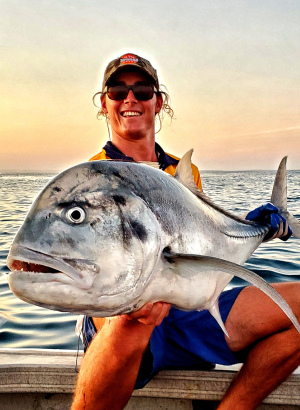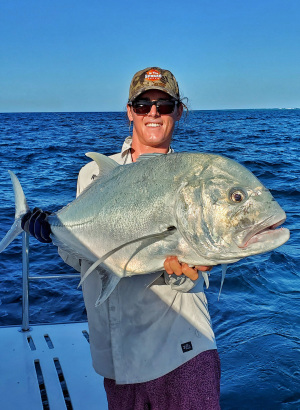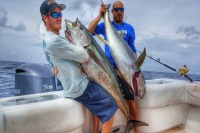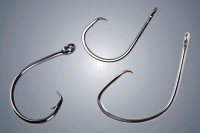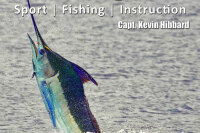Enter the realm of Giant Trevally fishing, where each cast invites a brutal encounter with the ocean's most formidable predator. Engage in this ultimate angling challenge, pitting your strength and wits against the raw power of GTs, and experience the pinnacle of sportfishing.
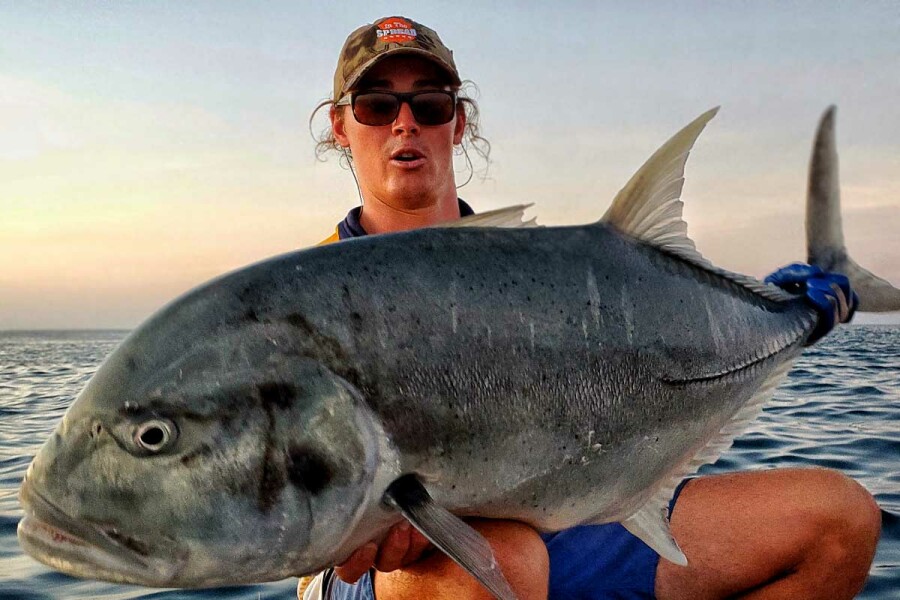
GT Power - Mastering the Gear and Techniques for Giant Trevally Success
- Introduction to GT: Overview of Giant Trevally's habitat, size, and why it's a sought-after game fish.
- Techniques for Catching GT: Explanation of various fishing techniques like popping, jigging, and fly fishing.
- Gear Recommendations: The brutal nature of this fish requires an exacting approach to tackle considersations.
- Rods: Characteristics of ideal rods for popping and jigging.
- Reels: Specifications for reels that can handle the power of GT.
- Line: Types of line suitable for different GT fishing techniques.
- Leaders: Importance and types of leaders for GT fishing.
- Hooks and Lures: Recommendations for sizes and types of hooks and lures.
- Finding GTs: Tips on locations and conditions for finding GTs.
- Battling GTs: Strategies for setting the hook and fighting GTs.
- Conclusion: Summarizing the thrill and techniques of GT fishing.
Introduction to Apex Predator Fishing
Adrenaline Rush of Fishing and the Challenge of Subduing These Brutes
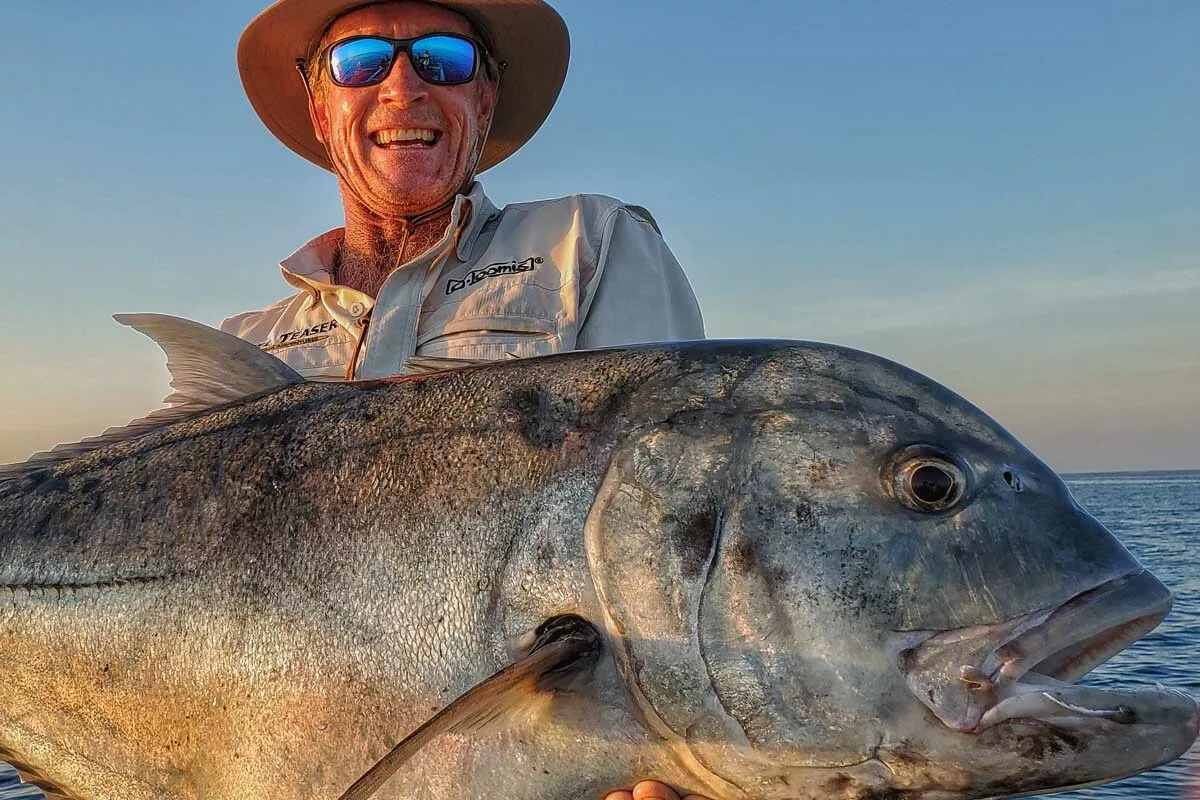
What is a Giant Trevally (GT)?
- Size and Appearance: Adult GTs are robust and muscular, with a steep forehead and a strong tail, which are adaptations for speed and power. They can grow quite large, often reaching lengths of over 150 cm (59 inches) and can weigh up to 80 kg (176 pounds). Their color varies from a silvery-white to dark grey or even black, depending on the environment and their age.
- Habitat: The Giant Trevally is predominantly found in the tropical waters of the Indo-Pacific region. Their habitat ranges from shallow coastal waters and coral reefs to deeper offshore areas. They are known to be highly adaptable, capable of surviving in a variety of marine environments.
- Behavior and Diet: These are apex predators with a voracious appetite, feeding on fish, crustaceans, cephalopods, and sometimes even small seabirds. They are known for their aggressive hunting tactics, often hunting in packs and using speed and power to overwhelm their prey.
- Sport Fishing: GTs are highly sought after by sport fishermen due to the challenge they pose. They are known for their strength and stamina, often putting up a vigorous fight when hooked, which can last for hours. Fishing for GT is considered a physically demanding sport, requiring strong gear and a good deal of skill and experience to handle the powerful fish.
- Conservation: While the Giant Trevally is not currently listed as endangered, it faces threats from overfishing and habitat destruction in some areas. Responsible fishing practices and regulations are important to ensure the sustainability of GT populations.
Where are GTs found?
- Indian Ocean: Present along the eastern coast of Africa, including the Red Sea, and extend eastward to the coastal waters of the Indian subcontinent and Southeast Asia. Top Indian Ocean destinations for GT fishing include the Seychelles, Maldives, Mauritius, Oman, Andaman Islands and Sri Lanka
- Western Pacific: Their habitat extends from the waters of Japan in the north to Australia in the south. This includes Papua New Guinea, Fiji, Soloman Islands, Vanuatu, New Caledonia, the Philippine Islands, Indonesia, and the myriad of islands in Micronesia and Polynesia.
- Central Pacific: The Hawaiian Islands, French Polynesia, Kiribati, Marshall Islands and Cook Islands are a well-known habitat for GTs, where they are locally known as "Ulua."
- Coral Reefs and Atolls: GTs are commonly associated with coral reefs, atolls, and lagoons where they can find ample food sources and shelter. They are often seen around the Great Barrier Reef and other similar ecosystems.
- Coastal Areas: Besides reefs, GTs can also be found in clear, shallow coastal waters, estuaries, and bays, especially where there is a strong presence of smaller fish that serve as prey.
Why are GTs So Popular Among Anglers?
- Impressive Size and Strength:These are fish are known for their large size and incredible power. Catching a GT is often considered a significant achievement due to the sheer physicality of these fish. Their size and strength make the battle to reel them in both challenging and exhilarating.
- Aggressive and Explosive Behavior: GTs are aggressive predators and are known for their explosive strikes and vigorous fights. They are highly tenacious and will often make long, powerful runs and perform acrobatic jumps, testing the skills and endurance of even the most experienced anglers.
- Sporting Challenge: The difficulty of hooking and landing a fish adds to its appeal. It requires skill, patience, and the right equipment. Anglers need to be well-prepared and in good physical condition to handle the fight a GT puts up, making it a prized catch for sport fishermen.
- Diverse Fishing Techniques: Fishing for these massive predators involves various techniques such as popping, jigging, and fly fishing, appealing to a wide range of anglers with different skill sets and preferences. The diversity of techniques also means that each fishing experience can be unique and challenging in its own way.
- Pristine and Exotic Locations: They are found in some of the most beautiful and remote marine environments in the world, from tropical coral reefs to secluded island atolls. Fishing for GTs often provides anglers with the opportunity to enjoy and explore these pristine natural settings.
- Symbol of Healthy Ecosystems: GTs are top predators in their habitats and are often considered indicators of a healthy marine ecosystem. Anglers who pursue GTs are often conservation-minded, appreciating not only the thrill of the catch but also the ecological significance of these fish.
- Cultural and Recreational Significance: In many coastal communities, GT fishing is an important part of the local culture and recreation. It contributes to the local economy through tourism and provides an avenue for social and community activities.
Popping and Jigging Fishing Techniques
Catching Giant Trevally (GTs) involves various techniques, each requiring specific skills and equipment. Two of the primary methods used by anglers are popping and jigging. Here's a brief description of each technique:
Popping
- Technique: Popping involves using a long, sturdy rod and a heavy-duty reel with a strong line. Anglers cast large, buoyant lures known as poppers towards target areas where GTs are likely to be feeding or patrolling. The popper is retrieved in a manner that creates a noticeable disturbance or 'pop' on the water's surface, mimicking an injured or struggling prey.
- Appeal: The visual spectacle of a GT striking a popper is dramatic and exhilarating. The aggressive surface strike and the subsequent fight make popping a highly popular and visually thrilling technique for targeting GTs.
Jigging
- Technique: Jigging involves using a heavy, vertically-oriented lure known as a jig. Anglers drop the jig to the desired depth and then use a series of rod motions to impart a jerky, up-and-down movement to the lure, simulating an injured or fleeing fish.
- Appeal: This technique is effective in deeper waters where GTs may be hunting below the surface. It requires physical effort and skill to animate the jig properly and can be very productive in enticing a strike from a GT lurking in the depths.
Each of these techniques offers a unique experience and requires a different set of skills and equipment. Anglers often choose their method based on the specific conditions, their personal preferences, and the behavior of the GTs in the area they are fishing. The thrill of successfully catching a GeeT using any of these techniques is a memorable achievement for any angler.
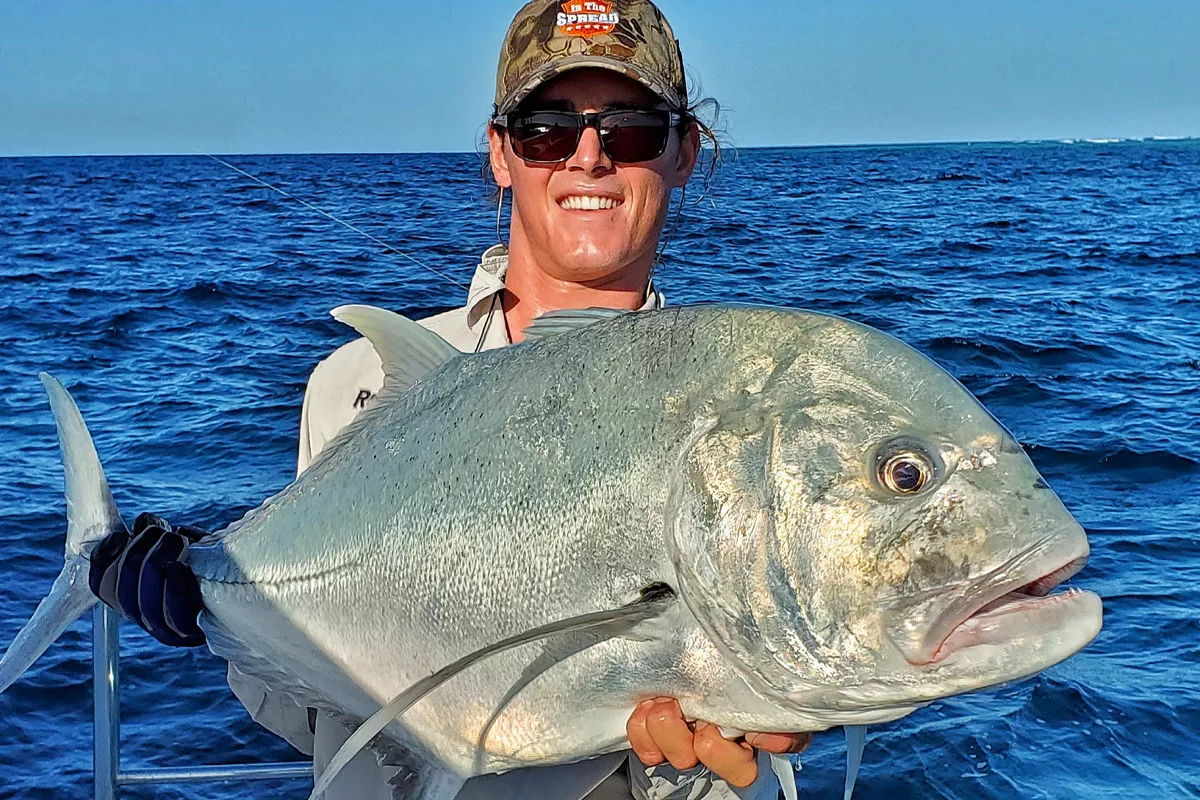
Gear Up for Battle
GT's are notorious for their ability to break lines, bend hooks, and smash rods with their sheer strength and aggression. Giant Trevally fishing requires heavy tackle, fast reactions, and a lot of endurance to subdue these beasts that can weigh up to 80 kg (176 lb). GT fishing is not for the faint of heart, but for those who seek the ultimate thrill and challenge in fishing.
Rods: What type of rod do you need? What weight and length are ideal?
For this type of fishing, choosing the right rod is crucial due to the size, strength, and fighting prowess of these fish. The ideal rod varies based on the technique used (popping or jigging), but certain characteristics are generally sought after to handle the power of GTs:
Popping Rods
For a successful encounter with the formidable Giant Trevally, the choice of rod is pivotal. Opt for a robust spinning rod, ideally designed to accommodate a line rating of Pe8 to Pe10. This rod should be proficient in managing a consistent drag pressure of at least 10 kg, crucial for withstanding the vigorous strikes and the intense battle that follows.
When it comes to rod length, aim for a span between 7’5” to 8’5”. This length is not just about reaching further with your cast but also about maintaining control over the fish during those critical moments of the fight. While an 80 lb class rod is the minimum threshold, a 100 lb class rod is optimal for an upper hand in this aquatic duel.
The action of the rod is equally significant. A fast to very fast action is the preferred choice, ensuring precision and smoothness in casting, coupled with a solid hook set. In terms of rod flex, a moderate action rod flexes in the upper half, while a fast action rod offers a more concentrated flex near the top third. This design feature ensures that the rod offers substantial backbone to combat the GT's might, all the while maintaining the finesse required for an effective lure presentation.
Specifically, for popping techniques targeting GT, the rods are crafted for endurance and flexibility. These rods are generally lengthier and offer more give than their jigging counterparts, enhancing cast performance and absorbing the shock from the strikes of these dynamic game fish. The ideal dimensions and build of a popping rod are contingent on the fish's size, the desired casting distance, and the lure type.
A top-notch popping rod for GT fishing should exhibit the following characteristics:
- Length: Ranging from 7.5 to 10 feet, tailored to the angler's preference and the constraints of the boat size. A longer rod excels in casting range and managing larger fish, while a shorter rod scores in maneuverability and ease of transport.
- Line Rating: Spanning from 50 to 150 pounds. The braided line is the preferred choice owing to its superior strength, sensitivity, and resilience.
- Lure Rating: Between 100 to 300 grams. This is to match the lure's weight with the casting distance and the intended casting dynamics. Heavier lures are synonymous with longer casts and more pronounced splashes, whereas lighter lures afford quicker and more subtle movements.
- Power: Either heavy or extra-heavy, calibrated to match the challenge posed by the GT. A heavy power rod is suitable for fish up to 100 pounds, while an extra-heavy variant can manage fish that tip the scales well in excess of 100 lbs.
Jigging Rods
In the realm of jigging for Giant Trevally, the choice of rod is a critical factor that significantly influences the outcome of the fishing experience. The strength and power of the rod are paramount, given the GT's notorious capacity for sudden, forceful strikes and the hefty jigs used in this technique. For this demanding style of fishing, heavy power rods are ideal. They are constructed to handle the aggressive behavior of GTs, ensuring that anglers have the upper hand in these intense encounters. Both spinning and conventional rods find their place in jigging, with the choice largely depending on the angler's personal preference and comfort. Rods within the 60 lb to 80 lb class are generally best suited for this purpose, offering a balance of strength and flexibility.
- Length: The length of jigging rods typically ranges from 5′ to 6’6”. These rods are often designed in two pieces for ease of transport and storage. A key aspect of their design is the line rating, which is usually pegged at Pe5 to Pe8. This specification is crucial as it determines the rod's compatibility with the line strength required to combat GTs. Additionally, these rods are optimized for jig weights between 150-400 grams, accommodating a variety of jigging styles and conditions. The choice of rod length is influenced by factors such as the angler's preference and the size of the boat. Shorter rods, while easier to handle and offering greater leverage, are ideal for quick, powerful jigs and tight situations. On the other hand, longer rods provide increased casting distance and better shock absorption, beneficial when targeting GTs in open waters or deeper spots.
- Action: When it comes to the action of the rod, fast or extra-fast actions are preferred for jigging. A rod with fast action bends primarily in the top third, while an extra-fast action rod bends only near the tip. This design feature allows for a more responsive feel and rapid power transmission during both the jigging motion and the battle with a GT. The swift action is essential for a quick and powerful hook set, ensuring the fish does not have the opportunity to spit out the jig.
- Line Rating: The line rating for these rods is typically set between 50 to 100 pounds, a range that can withstand the vigorous runs and intense head shakes characteristic of GTs. Braided line is the go-to choice for jigging, prized for its strength, sensitivity, and durability. It allows for better depth control and can withstand the harsh marine environment and the abrasive nature of the fight.
- Lure Rating: In terms of lure rating, jigging rods are generally designed to accommodate lures weighing between 100 to 300 grams. This range ensures that anglers can choose the appropriate jig weight based on the depth of the water and the desired jigging action. Heavier jigs are effective in reaching deeper waters and in creating more pronounced action, which is particularly useful in attracting GTs from afar. Lighter jigs, conversely, are suitable for quicker retrieval and can be advantageous in avoiding snags in complex underwater terrains.
- Power: Lastly, the power of the rod is a crucial consideration. Medium power rods are capable of handling fish up to about 50 pounds, making them suitable for smaller or medium-sized fish. However, for larger fish, heavy power rods are recommended. These rods can manage fish that weigh up to 100 pounds or more, providing the necessary strength and resilience needed in the intense tug-of-war that epitomizes GT fishing.
General Considerations
- Material: High-quality, durable materials like graphite or composite blends are common for GT rods to ensure they can withstand the immense forces during the fight.
- Line and Lure Weight Capacity: The rod should match the weight of the line and lure you plan to use. This usually means a high line and lure weight capacity.
- Quality Guides and Reel Seat: Given the saltwater environment and the size of GTs, rods with high-quality, corrosion-resistant guides and a sturdy reel seat are essential.
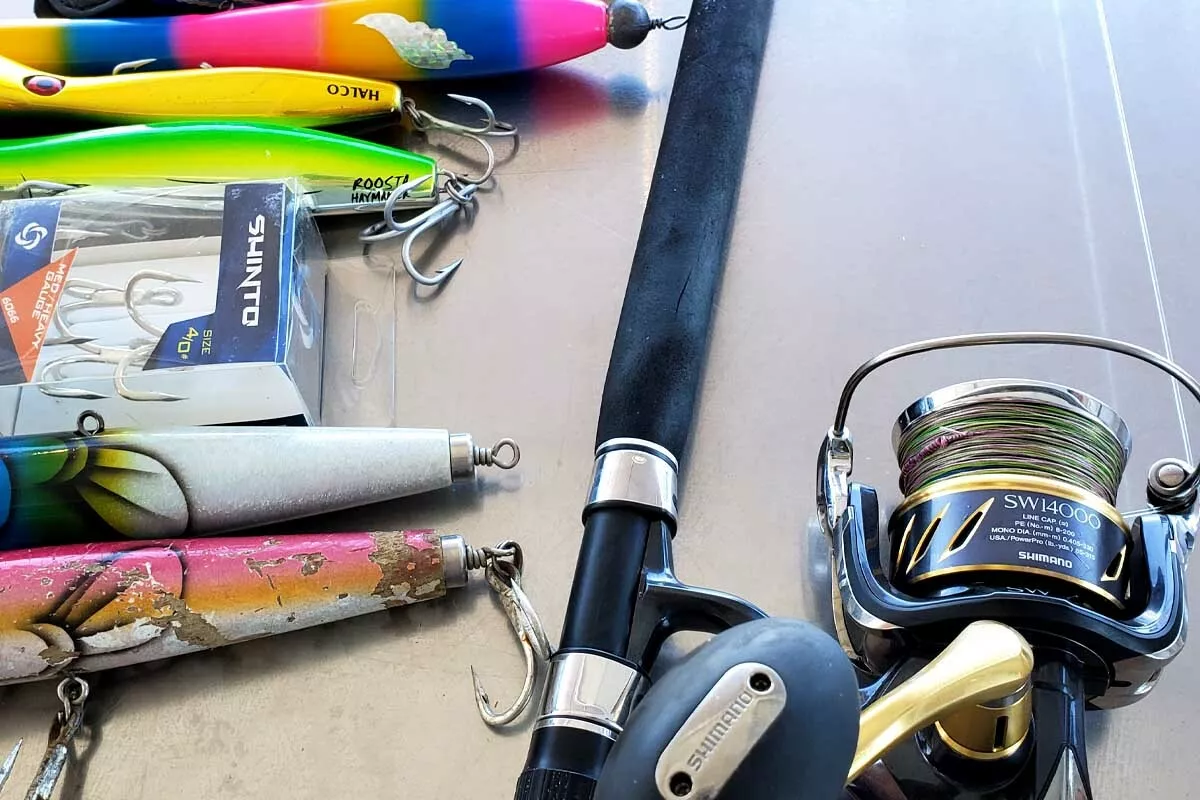
Reels: What type of reel can handle the power of these fish? How much drag should it have?
When targeting Giant Trevally, it's crucial to have a reel that can withstand their incredible power and long, forceful runs. The type of reel and its specifications must be up to the challenge. Here are the key considerations for choosing a reel for GT fishing:
Reels For Popping and Jigging
- Popping: A spinning reel like the Shimano Stella SW 14000 HG and upwards size or the Daiwa Saltiga 6000, 6500 size would be ideal for the job. For GT popping you will need a reel that has minimum retrieve/ Gear ratio of 5.0 to 1 and above and as earlier mentioned be able to put out at least 10kg drag smoothly and consistently. The line cap should be at least 180 meters of PE 8 and for the bigger fish you can use PE 8-12 on a reel being able to take at least 180 meters of it.
- Jigging: A quality spinning reel like the Shimano Stellas SW 20000, SW 18000, SW 10000 can be used. Also the Daiwa Saltiga range like the 6500 or 6000, may be used. However it is important to make sure that reels have a low gear ratio which makes jigging a far easier task and also provide the grunt needed for winching up hard fighting fish from the deep.
Regardless of the type of fishing (popping or jigging), it's crucial to pair your reel with a rod that balances well and suits your fishing style and the conditions you'll be facing. Investing in a high-quality reel with a strong, smooth drag system and ample line capacity can make a significant difference when battling a Giant Trevally. As always, maintaining your equipment, especially cleaning and servicing your reel after exposure to saltwater, will ensure its longevity and performance during those critical moments in a fight.
Line: What type of line is best for GT fishing? What braid weight should you use?
For GT fishing, a high-strength, durable line is essential to withstand the immense power and aggressive strikes of Giant Trevally. Braided line is the preferred choice due to its superior characteristics:
Line for Popping
- Strength and Durability: GTs are incredibly powerful and can easily break weaker lines. It's essential to use a high-strength, abrasion-resistant braided line to withstand the harsh conditions of the habitats, which often include coral reefs and rocky structures.
- Braid Weight (Line Strength): The weight of the braided line for GT popping should be heavy enough to handle the size and fighting power of the fish. Typically, anglers use braided lines in the range of 80-100 lb (36-45 kg) test. In some cases, and especially in areas with larger GTs or more abrasive terrain, anglers might opt for lines up to 130 lb (59 kg) test.
- Line Capacity: Ensure that your reel can hold enough line to accommodate the long runs that Giant Trevally are known for. A minimum of 300-400 yards of braided line is recommended, depending on the size of the fish and the fishing environment.
- Color: While color might not significantly affect the fish, it can help the angler. High-visibility colors like yellow, green, or multicolor lines allow anglers to see and manage the line better, especially when tracking the line's direction and detecting subtle movements during the retrieve.
- Knot Strength: Braided lines are slippery, and knots can come undone if not tied properly. Using the right knots and ensuring they are tightly secured is vital. A popular choice is the Palomar knot for its simplicity and strength. Additionally, many anglers use a monofilament or fluorocarbon leader attached to the braid to provide shock absorption and abrasion resistance, with the FG knot being a favored choice for connecting the leader to the braided line due to its low profile and strength.
Line for Jigging
- Strength and Durability: GTs are powerful fighters, and the underwater structures they inhabit can be rough on the line. A high-strength, abrasion-resistant braided line is essential. It should be able to withstand the initial strike and the subsequent fight, which often involves the line rubbing against coral reefs or rocky outcrops.
- Braid Weight (Line Strength): The weight of the braided line for jigging should be robust enough to handle the fish's size and strength. Anglers typically use braided lines in the range of 50-80 lb (23-36 kg) test. However, depending on the size of GTs in the fishing area and the structure of the underwater environment, some anglers may opt for lines up to 100 lb (45 kg) test or more.
- Line Capacity: It's important to have a reel that can hold a sufficient amount of line, considering the depth at which you're jigging and the potential for long, powerful runs by the GT. Having 300-400 yards of braided line is generally recommended.
- Line Diameter: For jigging, a thinner line is often preferable because it has less resistance in the water, allowing the jig to sink faster and with less effort. However, it's crucial to balance the need for a thin line with the need for strength and durability, especially when targeting powerful fish like GTs.
- Color: While the color of the line is less critical for the fish, it can be beneficial for the angler. High-visibility colors allow you to see your line better, which can be particularly useful for detecting strikes and managing line slack.
Leaders: Why are leaders important for GT fishing? What type of leader material should you use?
Leaders play a crucial role in GT fishing, serving as the critical connection between the mainline (usually braided) and the lure or hook. They are essential for several reasons, especially when targeting powerful and aggressive fish like Giant Trevally. Here's why leaders are important and what type of material you should consider:
- Abrasion Resistance: GTs often inhabit environments with coral reefs, rocks, or other abrasive structures. Leaders, being thicker and more abrasion-resistant than the mainline, can withstand contact with these rough surfaces, reducing the risk of the line being cut or frayed during the fight.
- Shock Absorption: The sudden strikes and fierce runs put immense pressure on the line. Leaders, particularly those made of monofilament or fluorocarbon, have a degree of stretch, acting as a shock absorber during these intense moments, and reducing the likelihood of the line breaking under sudden tension.
- Stealth: Braided lines are highly visible in the water. A leader, especially if made from fluorocarbon, is much less visible and can be crucial in clear water conditions where GTs may be line-shy. The leader makes the lure or bait appear more natural and less connected to the visible mainline.
- Bite Protection: GTs have strong jaws and sharp teeth. A sturdy leader material can withstand bites and prevent the fish from cutting the line.
Leaders for Popping
When it comes to popping, the entire fishing setup is subjected to extreme forces, not just from the powerful and aggressive strikes of the GTs but also from the high drag settings and the robust PE (Polyethylene) braided lines commonly used in this method. In such a high-tension fishing scenario, incorporating a good shock leader is not just beneficial—it's essential for successfully landing a GT. Here's an expanded view on the critical role of shock leaders in popping for GTs:
A shock leader serves as a crucial buffer, absorbing the tremendous forces generated during the cast, the strike, and the fight. When a GT strikes, it does so with explosive power, often followed by vigorous head shakes and tail whacks as it attempts to dislodge the lure. These movements create intense, sharp jolts that travel through the line. A high-quality shock leader, typically in the range of 170 lb to 220 lb test and about 1.5 to 3 meters in length, provides the necessary elasticity and strength to absorb these sudden bursts of energy. This absorption capacity protects the mainline from snapping and ensures that the force exerted by the angler is effectively transmitted to the fish without overstraining the system.
While both monofilament and fluorocarbon have their places in fishing, for popping and dealing with the dynamic, high-stress conditions of GT fishing, monofilament is often preferred as a shock leader material. The inherent stretchiness of monofilament makes it exceptional at absorbing shocks and sudden bursts of energy, which are common during GT strikes and subsequent fights. Moreover, the slightly thicker diameter of monofilament compared to fluorocarbon of the same strength adds an extra layer of abrasion resistance—a valuable asset when fishing around coral reefs and other rough structures where Giant Trevally are commonly found.
Certain brands have garnered respect in the angling community for producing high-quality shock leaders that meet the rigorous demands of GT fishing. Fisherman Stealth and Varivas Shock Leader are among the top choices. These brands are known for their superior strength, excellent abrasion resistance, and just the right amount of stretch. Anglers trust these leaders to maintain their integrity under the immense pressure of apex predator fishing, providing a reliable connection between the lure and the mainline.
Incorporating a well-chosen shock leader into your popping setup enhances your chances of success by providing a critical link that can withstand the brute force of a GT strike and the challenging conditions of fishing habitats. When paired with the right technique and high-quality gear, a shock leader becomes an indispensable component of the thrilling and rewarding experience of GT fishing.
Leaders for Jigging
When jigging, the choice and implementation of a leader are of paramount importance. The underwater terrain where GTs are often found can be rugged and unforgiving, with sharp coral outcrops, rocky structures, and other abrasive elements. Moreover, the aggressive nature of giant trevally, characterized by their powerful bites and the intense, unpredictable fights they put up, demands a leader that can withstand extreme conditions. Here's an expanded view on the crucial role of leaders in jigging for GTs:
A strong, abrasion-resistant leader is non-negotiable in jigging for GTs. The leader not only has to stand up to their powerful jaws and sharp teeth, but also endure the harsh, abrasive environment of their habitat. A leader in the 100-150 lb (45-68 kg) test range is typically employed, providing a robust barrier against the challenges posed by both the fish and its surroundings. The exact strength chosen can depend on factors such as the average size of GTs in the area, the ruggedness of the underwater terrain, and the angler's personal preferences and experiences.
Both fluorocarbon and monofilament have attributes that make them suitable as leader materials in GT jigging, but the choice between the two can be influenced by the specific conditions and requirements of the fishing scenario:
- Fluorocarbon: Known for its low visibility, excellent abrasion resistance, and minimal stretch, fluorocarbon is a favored choice for many anglers. Its refractive index is close to that of water, making it less noticeable to fish. This can be particularly advantageous in clear water conditions where GTs might be wary of the line. The reduced stretch of fluorocarbon provides a more direct and sensitive feel of the jig, which can be crucial in detecting subtle bites.
- Monofilament: Monofilament's inherent stretchiness can be beneficial, acting as a shock absorber during the sudden, forceful strikes of GTs and the ensuing battle. This elasticity helps in mitigating the risk of line breaks under sudden tension. Additionally, monofilament is generally more buoyant than fluorocarbon, which can affect the action and presentation of the jig, depending on the angler's technique and preferences.
Leader Length:
The length of the leader in GT jigging can vary, but it's typically between 3 to 6 feet (1 to 2 meters). A longer leader can provide more abrasion resistance and shock absorption but might be more challenging to manage, especially when bringing a fish close to the boat. Conversely, a shorter leader offers better control and is easier to handle but might provide less protection against abrasion and the powerful strikes.
The connection between the mainline (usually braided) and the leader is a critical junction that must be executed with precision. Using a strong, reliable knot that maintains the integrity of the line while minimizing its profile is essential to ensure a seamless transition through the rod guides and to maintain the lure's action. Popular knots for this purpose include the FG knot, Albright knot, or the improved clinch knot, each known for their strength and reliability when tied correctly.
In summary, selecting the right leader for jigging for GTs involves a balance of strength, abrasion resistance, and the right material properties to match the fishing conditions. A well-chosen leader, coupled with a proper knot and technique, significantly enhances the angler's ability to successfully land a GT, turning an intense battle into a memorable catch.
Hooks: What size and type of hooks are best for GT fishing?
For GT fishing, selecting the right size and type of hook is crucial due to the sheer power and size of Giant Trevally. The hooks need to be incredibly strong and durable to withstand the intense battles and prevent any chance of bending or breaking. Here are the recommendations for the size and type of hooks best suited for GT fishing:
Hooks for Popping
When it comes to popping for Giant Trevally, the selection of hooks is critical due to the extreme power and the aggressive nature of these fish. Only the strongest, most durable hooks should be considered to ensure that they can withstand the GT's ferocious strikes and the intense battles that ensue. Here's an expanded view on the importance of choosing the right hooks for popping:
GTs are notorious for their ability to exploit any weakness in your tackle, and hooks are no exception. It's imperative to choose hooks like the Decoy GT Special in sizes 8/0 and 10/0, renowned for their strength and reliability. These hooks are engineered to maintain their integrity and sharpness even under the immense pressure exerted by a battling GT, ensuring a secure hook-set and reducing the likelihood of straightening or breaking.
Several brands are recognized for producing hooks that meet the rigorous demands of popping. Apart from the Decoy GT Special, BKK TREX in sizes 5, 6, and 7, and Gamakatsu GT Recorder in size 6/0 and upwards are highly recommended. These hooks are not only strong but also designed with specific features that cater to the needs of GT fishing:
- Decoy GT Special: Designed for the biggest, hardest fighting fish and mega species on the planet,
- BKK TREX: Known for their robust construction and superior penetration, BKK TREX hooks offer the strength needed to handle the explosive power of GTs. Their wide size range allows anglers to match the hook to the size of their lures and the GeeT they are targeting.
- Gamakatsu GT Recorder: These hooks are praised for their exceptional strength and sharpness. The barbless design is a significant advantage, as it facilitates easier, safer hook removal, which is beneficial for both the fish and the angler, especially during catch-and-release fishing or when managing hooks on board.
Importance of Barbless Hooks:
The mention of barbless hooks, particularly for the Gamakatsu GT Recorder, highlights a growing trend in responsible angling. Barbless hooks are easier to remove, minimizing the injury to the fish and aiding in quicker, more successful releases. Additionally, in the high-action environment of GT popping, where hooks can become hazards, barbless hooks offer a safer option, reducing the risk of serious injury to the anglers in case of accidents.
Regardless of the brand or type, maintaining your hooks is crucial. Regularly checking for sharpness and integrity, and replacing any that show signs of wear, damage, or dullness, ensures that your gear is always in top condition. This attention to detail can make a significant difference in the success of your GT popping adventures.
In conclusion, investing in high-quality, strong hooks and maintaining them well is indispensable in GT popping. The right hooks not only increase your chances of securely hooking and successfully landing a GT but also contribute to safer, more sustainable fishing practices.
Hooks for Jigging
In the realm of jigging, the importance of using high-quality terminal tackle cannot be overstressed. Every component, from the hooks to the rings and assist cords, plays a pivotal role in not just hooking but also successfully landing these formidable fish. Here's an expanded view on the essential terminal tackle for jigging for GTs:
Assist hooks are a crucial element in jigging, particularly for powerful species like GTs. These hooks are attached to the jig via a heavy-duty cord, allowing the hook to move freely and providing a more natural action. This freedom of movement increases the chances of a solid hook-up, as it allows the hook to set more easily in the fish's mouth. For jigging, robust assist hooks in the size range of 9/0 to 13/0 are standard. The large size ensures that the hook is proportional to the large jigs used for GTs and capable of handling their strength and size. These hooks must be made of high-grade material to maintain sharpness and strength, even after repeated exposure to saltwater and the powerful jaws of these predators.
The rings used in jigging must be of the highest quality, capable of withstanding the extreme forces exerted during a GT fight. Split rings and solid rings should have a minimum breaking strain of 200 lbs to ensure they don't fail under pressure. The rings are the critical connection points between the jig, the assist hooks, and the main line or leader. Any weakness in these connections can result in a lost fish or damaged tackle. Therefore, it's crucial to choose rings that are not only strong but also properly sized to maintain the lure's action and ensure a secure attachment of the hooks.
The cord used to attach the assist hooks to the jig is another critical component. Kevlar assist cord is widely favored for this purpose due to its exceptional strength and abrasion resistance. Kevlar's robust properties ensure that the cord can withstand the sharp teeth and powerful pulls of a GT without fraying or breaking. Having a supply of quality Kevlar assist cord allows anglers to replace or adjust their assist hooks as needed, ensuring that their jigging setup remains in optimal condition throughout their fishing expedition.
In summary, when jigging, the terminal tackle's integrity is as crucial as any other part of the fishing setup. High-quality assist hooks, heavy-duty rings, and durable assist cords are fundamental components that, when chosen and used correctly, significantly enhance the success rate of landing these mighty fish. It's a testament to the principle that in GT fishing, every detail matters, and the strength and quality of the smallest components can make all the difference in the outcome of your fishing adventure.
Split Rings
The use of heavy-duty split rings is a fundamental aspect of GT fishing, both for popping and jigging. These small but critical components bear a significant portion of the strain during the fight with a GT and thus play a pivotal role in the overall strength and integrity of your fishing setup. Here’s an expanded view on the advantages of using heavy-duty split rings and the recommended brands:
- Strength and Durability: Heavy-duty split rings are specifically designed to withstand the extreme forces exerted by powerful fish like giant trevally. A GT's strike and subsequent fight put immense pressure on every component of the tackle, and a split ring's failure can lead to losing the fish. High-quality, heavy-duty split rings, with a recommended strength of 200 lb or more, ensure that the connection points between the lure, hooks, and line remain secure throughout the battle.
- Corrosion Resistance: GT fishing often takes place in saltwater environments, which can be harsh on tackle. Heavy-duty split rings are typically made from materials that are resistant to corrosion, ensuring longevity and consistent performance, even after repeated exposure to salty conditions.
- Flexibility and Functionality: While their primary purpose is strength, heavy-duty split rings also offer the right balance of flexibility. This flexibility is crucial for ease of attachment when changing lures or hooks and for maintaining the natural action of the lure in the water. A rigid ring can impede the lure's movement, while a ring that's too flexible might not hold up to a GT's power.
Recommended Brands:
When it comes to choosing split rings for GT fishing, it’s essential to opt for brands known for their quality and reliability. Owner, Varivas, and Decoy are among the top choices, trusted by seasoned anglers worldwide:
- Owner Split Rings: Known for their high-quality fishing tackle, Owner's split rings are made with precision and strength, ensuring a reliable performance against the toughest fish.
- Varivas Split Rings: Varivas is another reputable brand that offers heavy-duty split rings, known for their durability and resistance to deformation and corrosion.
- Decoy Split Rings: Decoy provides a range of fishing tackle, including split rings that are specifically designed to handle large, powerful species like GTs. Their rings are praised for both strength and flexibility.
Using heavy-duty split rings from these trusted brands ensures that every link in your fishing setup is robust and capable of withstanding the challenges of GT fishing. Whether you’re popping on the surface or jigging in the depths, the peace of mind that comes from using the best possible components allows you to focus on the thrill of the fight, confident that your gear is up to the task.
GT Lures
Poppers
Popping lures are a favorite for GT fishing due to the aggressive nature of the fish and their propensity to strike surface lures with incredible force. The best popping lures for GTs are typically robust, well-built, and able to create a significant disturbance on the water's surface to attract the fish. Here are some considerations for choosing the best popping lures for GTs, including effective colors and sizes:
- Durability: GTs are powerful and can easily destroy weak lures. Poppers should be made of high-quality, sturdy materials with strong hooks and split rings to withstand the brute force of a strike.
- Size: GT poppers are generally larger than those used for other species. Lures ranging from 6 to 10 inches (15 to 25 cm) are common. The size of the lure can be matched to the baitfish in the area and the size of the fish you are targeting.
- Weight: The weight should be enough to allow for long casts, which is crucial when fishing for GTs. Poppers weighing between 100 to 200 grams or heavier are typical, but the exact weight can vary based on the fishing conditions and the tackle used.
Color and Design:
- Color: While GTs can be opportunistic and aggressive towards a variety of colors, some proven effective colors include:
- Bright colors like blue, pink, green, and yellow for clear water conditions.
- More natural colors like silver, blue, or patterns that mimic local baitfish for murkier waters or when fish are more hesitant.
- High-contrast colors or combinations (like black and red or blue and white) can be effective in a range of conditions.
- Design and Action:
- The lure's design should create a noticeable disturbance on the water surface. This can be a 'blooping' or popping sound and a splash, mimicking an injured or distressed prey.
- Some poppers have a cupped face to push more water and create a louder pop, while others have a slimmer profile to skitter across the surface and mimic fleeing baitfish.
Specific Lure Recommendations:
While the choice of lures can be subjective and influenced by personal preference and local conditions, some popular GT popping lure brands and models include:
- Halco Roosta Haymaker
- Shimano Ocea Bomb Dip
- Nomad Design Chug Norris
- Shell Shaping Lures
- CB One Bazoo
It's always a good idea to have a variety of lures in different colors and sizes to adapt to the conditions, the behavior of the fish, and the type of baitfish present in the area. Observing the local prey and conditions can provide valuable clues about which lures might be most effective on any given day.
Finally, remember that the most important factors in successful GT fishing are often the technique of the retrieval and the ability to place the lure accurately where the fish are feeding or patrolling. Coupled with the right lure, these skills dramatically increase your chances of a thrilling encounter with a Giant Trevally.
Stickbaits
Stickbait lures are highly effective for targeting Giant Trevally's, particularly when the fish are focused on baitfish near the surface or are reluctant to hit larger, more aggressive poppers. Stickbaits, with their streamlined shape and subtle action, mimic the movement of an injured or fleeing baitfish, provoking the predatory instinct of GTs. Here's what you need to consider when selecting stickbait lures for GT fishing, including the most effective colors and sizes:
- Durability: GTs are known for their powerful strikes and strength. It's crucial to select stickbaits that are built tough, with heavy-duty construction, strong split rings, and hooks capable of withstanding the fishes force.
- Size: The size of the stickbait can vary depending on the prevalent baitfish in the area and the size of the GTs you are targeting. Generally, stickbaits ranging from 6 to 10 inches (15 to 25 cm) are effective. Larger lures can attract bigger fish, but smaller lures may get more strikes in certain conditions.
- Weight: Choose a lure that is heavy enough for casting long distances, as reaching distant feeding GTs or covering a large area is often necessary. Stickbaits weighing between 80 to 200 grams are commonly used.
Color and Design:
- Color: The choice of color can depend on the clarity of the water, the weather conditions, and the type of baitfish present. Some popular color choices include:
- Bright, flashy colors (like silver, blue, pink, or green) in clear water or sunny conditions.
- Natural, more subdued colors (like silver, green, or patterns that mimic local baitfish) in overcast conditions or murkier water.
- High-contrast colors (like black and orange or blue and white) can be effective in a variety of conditions.
- Design and Action:
- Stickbaits can be floating, sinking, or suspending. The choice depends on the fishing conditions and the depth at which the GTs are feeding.
- The lure should have a realistic, enticing action. Some stickbaits are designed to be worked with a walk-the-dog style on the surface, while others have a wobbling or sliding action when retrieved.
Specific Lure Recommendations:
While lure preferences can vary among anglers and different fishing conditions, some widely recognized stickbait brands and models for fishing include:
- Rave Lure 220
- Heru Cubera
- Native Works Gazelle
- Carpenter Gamma GT-y 250
- Orion Bigfoot
When selecting stickbaits, it's beneficial to have a variety of options in terms of color, size, and sinking behavior to adapt to the day's conditions and the GTs' behavior. Observing the local baitfish and how GTs are feeding can provide valuable insights into the most effective lure choice.
Finally, the technique used to work the stickbait can be as important as the lure itself. A well-presented stickbait, with a natural, erratic action, can be irresistible to a GT, triggering explosive strikes and memorable battles.
Jigs
Jigging lures, also known as jigs, are an excellent choice for targeting GTs, especially when they're holding in deeper water or are less inclined to strike surface lures. The rapid, vertical motion of a jig can mimic a wounded or fleeing baitfish, provoking the predatory instincts of a GeeT. When choosing jigs, consider the following aspects to ensure you have the most effective weights and styles:
- Durability: GTs are incredibly strong and can easily damage or destroy weaker lures. Choose jigs made from sturdy materials, with robust hooks and solid rings that can withstand the intense strikes and the powerful fight of a GT.
- Weight: The weight of the jig should be suitable for the depth at which you are fishing and the current conditions. For GT jigging, weights typically range from 150 to 300 grams (5 to 10 ounces). Heavier jigs may be necessary in deeper waters or strong currents to maintain contact with the lure and ensure it reaches the desired depth.
- Shape and Action: The shape of the jig can influence its action in the water and its ability to sink quickly to the desired depth. Some common styles include:
- Knife Jigs: These have a slim, elongated shape and flutter as they fall, mimicking a wounded baitfish.
- Flutter Jigs: These are wider and flatter, designed to create a fluttering action on the drop, which can be very enticing to GTs.
- Paddle Tail Jigs: These have a broad, rounded end that creates a distinct action during the retrieve, often used in slower jigging techniques.
Color and Design:
- Color: The choice of color can depend on several factors, including water clarity, light conditions, and the prevalent baitfish. Common color choices include:
- Bright and reflective colors (like silver, blue, or pink) in clear water or when trying to mimic specific baitfish.
- More subdued or natural colors (like brown, green, or black) in murkier water or low light conditions.
- Glow-in-the-dark or UV-reflective jigs can be particularly effective in deep water or when fishing at dawn, dusk, or at night.
- Additional Features: Some jigs come with added features like assist hooks, which are hooks attached to the top of the jig with a short length of heavy-duty cord. These can provide a better hook-up rate as GTs often strike at the head of the lure.
Specific Jig Recommendations:
While jig preferences can vary among anglers and according to different fishing conditions, some popular jig brands and models known for their effectiveness in GT fishing include:
- Shimano Butterfly Jig
- Daiwa Saltiga Sacrifice Jig
- Williamson Abyss Speed Jig
- CB One G2
- Shout Lance
- Nature Boys Wiggle Rider 130g
Having a variety of jigs in different weights, shapes, and colors allows you to adapt to various conditions and depths, increasing your chances of success. The technique used to work the jig—varying the speed and rhythm of your retrieve—can also be crucial in triggering a strike from a Giant Trevally.
In summary, selecting the right jig for GT fishing involves considering the fishing depth, water conditions, and the type of baitfish you're trying to imitate. A well-chosen jig, coupled with a good jigging technique, can make all the difference in enticing these powerful fish to bite.
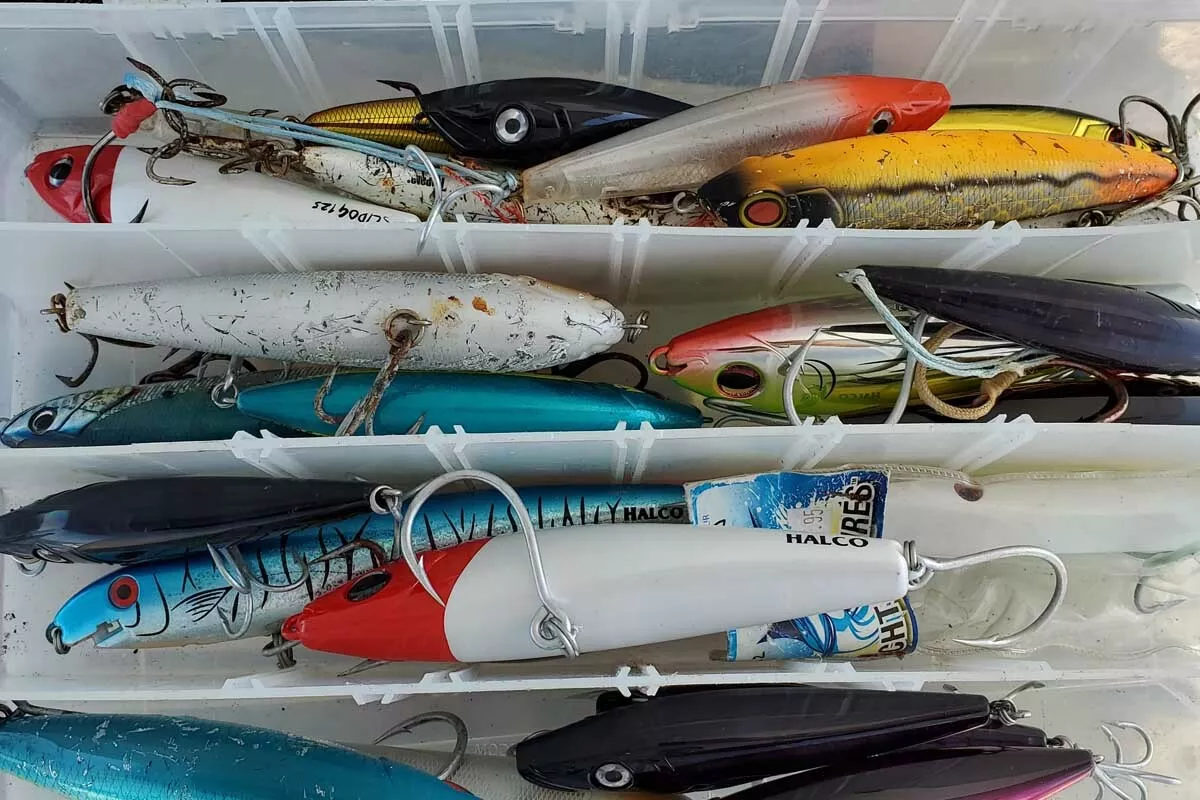
The Challenge of Finding GT's
Finding Giant Trevally presents several challenges, largely due to their habitat, behavior, and the environmental conditions of the regions they inhabit. Here are some of the biggest challenges anglers typically face when seeking out these formidable fish:
- Locating Habitats: GTs are usually found in specific marine environments like reefs, atolls, drop-offs, and channels. These areas can be vast and variable, making it challenging to pinpoint where the GTs might be feeding or patrolling at any given time. Knowledge of the local marine geography and fish behavior patterns is crucial.
- Understanding Behavior: GTs have complex behaviors that can be influenced by factors like tides, water temperature, time of day, and availability of prey. Their feeding patterns can change, making them somewhat unpredictable. Anglers need to understand these behaviors and adapt their strategies accordingly.
- Dealing with Weather and Water Conditions: Giant Trevally fishing often involves dealing with the elements, from high winds and rough seas to extreme sun exposure. Additionally, water conditions like clarity, current, and temperature can significantly affect the presence and activity of GTs.
- Access to Remote Locations: Some of the best fishing spots are in remote or inaccessible areas, requiring significant effort or resources to reach. This can include long boat rides or the need to charter specialized fishing vessels, making the logistics a challenge.
Where to Look
GT's are known for their predatory nature and can be found in various marine environments where they can effectively ambush prey. When targeting them, understanding their preferred habitats and hunting grounds is crucial. Here are some key areas where GeeTs are commonly found:
- Reefs and Coral Atolls: GTs are often associated with coral reefs and atolls where there is an abundance of smaller fish for them to prey upon. These structures provide plenty of hiding spots for GTs to ambush their prey. Look for areas with healthy coral cover, drop-offs, and channels within the reef.
- Channels and Passages: Channels or passages between islands or through atolls can be hotspots, especially when the tide is moving. These areas funnel currents and baitfish, making them ideal for giant trevally to hunt.
- Drop-offs: Areas where the reef or sea floor drops off sharply are excellent places to find fish. These predators often patrol the edges of drop-offs, looking for an easy meal as baitfish move in and out of the deeper waters.
- Wrecks and Artificial Structures: Shipwrecks or any artificial structure in the water can attract a myriad of marine life, including baitfish, which in turn can attract GTs. These structures provide shelter for smaller fish and excellent ambush points.
- Lagoons and Flats: In some areas, especially within atolls, GTs can be found in shallow lagoons and flats where they chase baitfish. Sight casting to GTs in these shallow waters can be particularly thrilling.
- Rocky Outcrops and Headlands: Areas where the coastline features rocky outcrops or headlands can be productive. The turbulent water around these structures is ideal for GTs to hunt.
When searching for fish, it's also essential to consider factors like the time of day, tides, and the presence of baitfish. GTs are more active during certain times, such as early morning or late afternoon, and they often follow the movements of their prey, which can be influenced by tidal changes.
Understanding the behavior of these predators and their relationship with the environment can significantly increase your chances of success. It's also crucial to respect these habitats by practicing sustainable fishing methods and adhering to local regulations to ensure the health and longevity of GT populations and their ecosystems.
Time of Day for Peak Activity
Known for their opportunistic feeding behavior, GT's exhibit periods of increased activity that are influenced by various environmental factors. Understanding these patterns can significantly enhance your chances of a successful encounter. Generally, these predators are most active during the following times:
- Early Morning: Just after sunrise, the low light conditions and the general increase in marine activity make this a prime time for Gs to hunt. Baitfish are often more active during this time, and GTs take advantage of the reduced visibility to ambush their prey.
- Late Afternoon to Dusk: Similar to early morning, the low light conditions during this time provide ideal hunting conditions. The change from daylight to dusk triggers a spike in marine activity, and GTs are known to feed aggressively before nightfall.
- Tidal Changes: Predators known to be more active during specific tidal phases, particularly during the incoming or outgoing tides. These tidal movements concentrate baitfish and create currents that are use to their advantage for hunting. The exact timing can vary based on the specific location and the moon phase.
- Night Time: In some locations, GTs are known to feed actively at night, especially in areas with ample moonlight or in well-lit environments like near piers or other artificial light sources. However, fishing at night requires extra caution and is generally more challenging.
- Specific Feeding Periods: Specific feeding periods are influenced by the availability of prey, water temperature, and other environmental factors. These periods can sometimes be observed and predicted based on local knowledge and experience.
While these times are generally considered optimal for targeting GTs, it's worth noting that they can be caught throughout the day, especially if the conditions are right and they are actively feeding. Being aware of the local conditions, consulting with experienced guides, and spending time observing the behavior of trevally and their prey can provide valuable insights into the best times to fish.
Tides and Weather Conditions
Tides and weather play a significant role in influencing the behavior of marine life. Understanding how these factors affect GT activity can be crucial in planning a successful fishing trip. Here's how tides and weather can impact fishing:
- Tidal Movement: GTs often feed more actively during periods of strong tidal movement, such as during the incoming or outgoing tides. The movement of water can concentrate baitfish and other prey, making them more vulnerable and easier to hunt.
- Tidal Phases: Some anglers find that certain tidal phases, such as high tide or low tide, can be more productive depending on the fishing location. For example, high tide might bring GTs closer to shore or into shallow flats and lagoons, while low tide might concentrate fish in deeper channels or holes.
- Change of Tides: The periods just before or just after the change of tides (slack tide) can also be effective times for GT fishing. During these times, the reduced water movement can make giant trevally more likely to take advantage of the temporary concentration of prey.
Weather:
- Wind: Moderate wind can be beneficial for giant trevally fishing as it creates surface disturbance, reducing the water's clarity and making GTs less wary and more likely to strike at lures or bait. However, strong winds can make casting difficult and may churn up the water too much, dispersing baitfish and making fishing challenging.
- Barometric Pressure: Changes in barometric pressure, often associated with incoming weather fronts, can affect fish behavior. Some anglers believe that the fish feed more aggressively when the pressure is dropping, anticipating the change in weather.
- Cloud Cover: Overcast conditions can be favorable for fishing, especially for surface techniques like popping. The reduced brightness and absence of sharp shadows can make GTs more confident to hunt in shallow waters or near the surface.
- Rain: Light to moderate rain can improve fishing conditions by breaking up the water's surface and reducing visibility, which can make GTs less cautious. However, heavy rain can lead to reduced salinity and visibility in coastal waters, potentially dispersing baitfish and making fishing more difficult.
- Water Temperature: Giant trevally, like many fish species, are sensitive to changes in water temperature. Sudden drops or increases in temperature can affect their feeding patterns. They tend to prefer stable, warmer water conditions, which are more conducive to the presence of baitfish.
While these general patterns can guide when and where to fish, it's essential to consider local conditions and patterns, which can vary from one place to another. Experienced local guides or fellow anglers can provide invaluable insights based on their observations and experience in the area. Additionally, always prioritize safety, especially when weather conditions are unpredictable or adverse.
Doing Battle with These Reef Donkeys
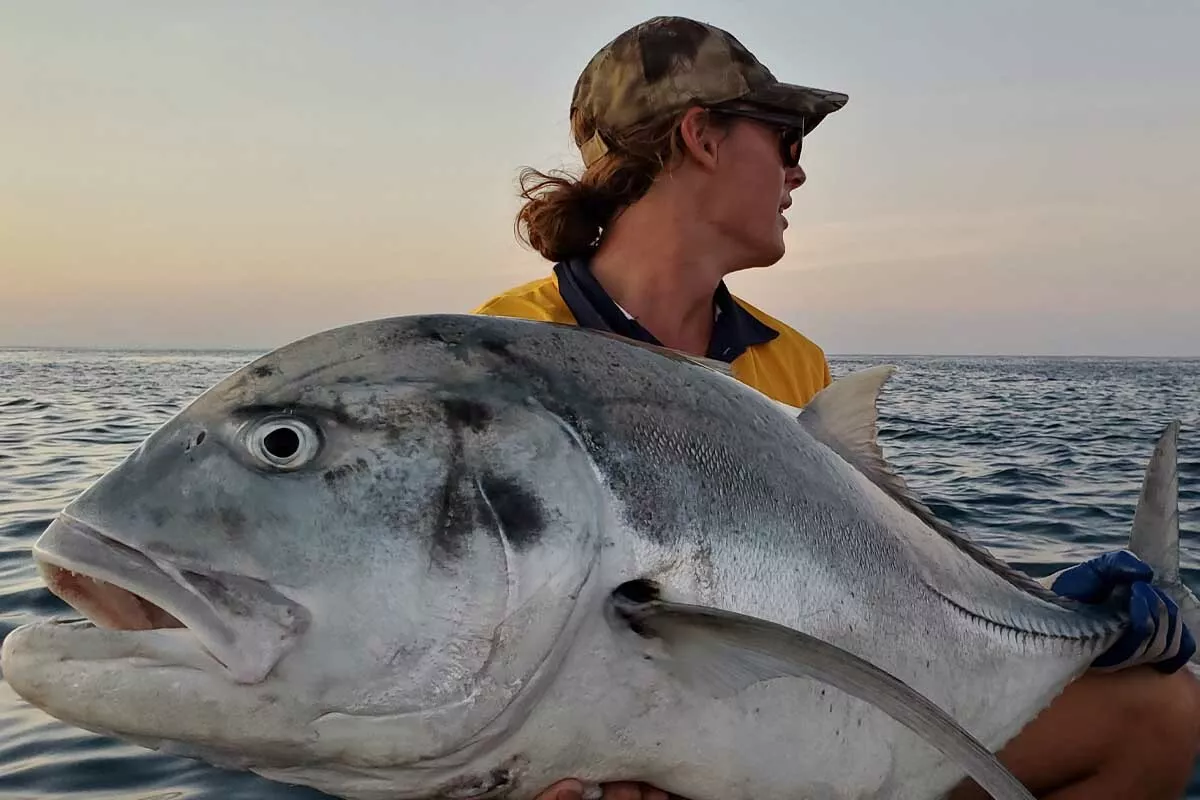
Setting the Hook
Setting the hook on a Giant Trevally is a critical moment that requires both precision and force. Given their incredible power and propensity for explosive initial runs, it's crucial to set the hook firmly to ensure a solid connection. When a G strikes, it often does so with immense force, and your response needs to match this intensity to prevent the fish from escaping and to withstand the pressure of its initial run.
As soon as you feel the strike, react swiftly by pulling the rod up and back with a strong and decisive motion, ensuring the hook penetrates firmly into the fishes tough mouth. This action should be both forceful and controlled; overly aggressive jerking can lead to broken lines or hooks, while a timid hook set might result in a weak hook hold, giving the GT an opportunity to throw the hook during its vigorous fight.
Using a high-quality, heavy-duty rod and reel combo suited for GT fishing is crucial, as it provides the necessary strength and leverage for an effective hook set. Equally important is using a braided line for its lack of stretch, ensuring that the force you apply travels directly to the hook. Once the hook is set, be prepared for the powerful initial run. Maintain steady pressure on the fish, allowing the drag system of your reel to do its job in managing the line's tension without breaking.
It's also essential to keep the line tight throughout the battle, as any slack can provide a chance to dislodge the hook. The combination of a firm, well-timed hook set, proper gear, and a controlled response to the GT's movements is key to successfully landing these formidable opponents. As with all aspects of fishing, experience, and practice play significant roles in mastering the art of setting the hook on a GT, so patience and persistence are your allies in this thrilling aspect of angling.
Fighting the Fish
Successfully fighting a GT requires a blend of strength, technique, and patience. Once you've set the hook, the real battle begins. GTs are renowned for their powerful runs and stamina, and your approach to fighting the fish should be strategic to avoid getting broken off. The key is to apply steady, consistent pressure, working the fish gradually without rushing the process.
First and foremost, it's crucial to maintain a firm and steady line tension. Any slack in the line can give the fish a chance to spit the hook. Instead of aggressive pumping and reeling, which can lead to a broken line or hook, maintain a smooth and steady pressure. Let the drag system of your reel do its work, allowing the GT to take line when it makes a powerful run, but ensure the drag is set tightly enough to tire the fish with each run.
Use the rod as a fulcrum to leverage the fish's strength against itself. Keep the rod tip up and angle it in the opposite direction of the fish's movement. This posture maximizes the rod's power and flex, helping to absorb the shocks and surges of the runs. When the fish runs, hold your position firmly, relying on the rod's resistance and the drag's tension to tire the fish. As the bursts become less intense, you can start retrieving line, but always be ready to let it run again if needed.
Pacing is crucial. Fights can last for a considerable time, and rushing can lead to mistakes or equipment failure. Stay calm, focused, and in tune with the fish's movements. As the GT tires, it will make shorter runs, and its movements will become less vigorous. This is your opportunity to steadily gain line, but always be prepared for a sudden burst of energy, as GTs are known for their surprising endurance.
Remember, fighting a GT is a marathon, not a sprint. Patience, combined with the right technique and gear, will gradually tip the balance in your favor. Respect the strength and resilience of the fish, and with perseverance, you'll increase your chances of successfully landing this formidable adversary.
In Conclusion
Giant Trevally fishing transcends the typical angling experience, evolving into an adrenaline-infused adventure. The pursuit of GTs is not merely a pastime but a quest for an encounter with raw power and natural ferocity. In the expanses of the Indo-Pacific region, these formidable predators reign supreme, commanding respect with their impressive size, sheer strength, and predatory finesse. The anticipation of a GT's explosive strike is akin to wrestling a rodeo bull, a moment of pure adrenaline where time stands still, and your angling skills are put to the ultimate test.
These are not just fish; they are brutal apex predators, patrolling the waters with an unmatched presence. Their aggressive nature and relentless pursuit of prey make them a symbol of the wild, unyielding forces that lie beneath the waves. Fishermen seeking to match wits with these leviathans are drawn not only to the physical challenge but to the profound connection with the primal essence of the sea.
The battle with a GT is an intense test of ones fishing skills, where every move and countermove can be the absolute difference between success and failure. You must be able to capitalize on the rod's strength, using it as a fulcrum to channel and counter the GT's raw energy. This confrontation is more than a test of physical endurance; it's a mental chess game, requiring patience, precision, and an intuitive understanding of the fish's behavior. Each run, each dive, and each surface breach is a testament to a GT's indomitable will, met by the angler's unwavering resolve.
In the world of sportfishing, GT fishing stands out as a pinnacle experience, a blend of excitement, respect, and admiration for one of nature's most impressive athletes. It's an immersive journey that goes beyond catching a fish, offering a profound interaction with the marine environment and a humbling reminder of our place within it. For those who seek the thrill of GT fishing, it is not just a casual outing, but a passionate pursuit, a way to connect with one of the oceans true beasts. It is a story of one of the most epic fishing adventures you can ever undertake.

